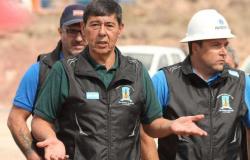Thirty years have passed since, in 1994, the engineer and writer Juan Antonio Bley (1957) published his novel “Colmo”, a science fiction text set in the quiet plains of Concón, next to the Aconcagua River, where an impressive technological utopia.
What Bley did not know is that, three decades later, some of the premises of his creation would be reflected in reality, turning “Colmo” into a novel of anticipation.
Heir to the best tradition of Jules Verne and Arthur C. Clarke, the novel is set in the first decades of the 21st century, when an energy revolution breaks out: the “hydrogen age,” which comes to replace polluting fossil fuels.
Thanks to the availability of this new source of energy, a skilled and creative engineer born in Valparaíso develops an unthinkable project: taking advantage of the Earth’s heat to generate geothermal energy directly from the depths of the planet.
To do this, engineer Axel Gutiérrez, supported by a powerful corporation, leads the construction of the deepest well in the world in the town of Colmo, in order to obtain underground steam. His ambitious utopia will go even further when he encounters a river of magma that allows him to create the first artificial volcano on the planet and, in the process, forever change the face of the Chilean coast.
Through his novel, Bley anticipated not only the problems of climate change that affect the planet due to the use of fossil fuels, but he also conceived a world where hydrogen energy, so in vogue today, emerges as a concrete alternative. and clean, and where innovative technologies to dig towards the heart of the planet are already a reality. And, unlike other dark dystopias, he conceived a future that takes charge of the urban and social problems that affect the country, projecting a more promising future, through an exciting technological adventure.
The novel “Colmo” (Editorial Emergence Narrative) will be presented this Tuesday, April 23, at 6:00 p.m., at the Municipal Library of Providencia, as part of the Book and Reading Day activities. On the occasion, the author will talk with the editor and journalist Marcela Küpfer.
The use of hydrogen
-What inspired you to write “Colmo” thirty years ago?
-About 10 or 11 years old I read “Journey to the Center of the Earth” by Jules Verne, and I was so fascinated that my whole life I kept thinking about what kind of fantastic journey I could ever write. And since everything had been exhausted since Julio himself, I had no other alternative but to imagine and then write “Colmo”. And all that was forged in my life around 1993.
-Why did you choose that town to set your novel?
-My vacations as a child to Viña were always very brief, but the landscapes of the V Region remained etched in me. And I think that the view of the Concón refinery itself was decisive. To clarify a bit, you will remember that the places I imagined in the novel to carry out explorations were nine. But Concón and the mysterious region of Colmo were predetermined.
-30 years ago, hydrogen was not yet projected as a fuel that was part of our energy matrix, contrary to what happens today. How did you arrive at this anticipation?
-I never liked the dirty combustion of hydrocarbons to power transport and I never accepted that the piston engine had won over the electric motor, which is rotary and much simpler. I knew about the existence of fuel cells (the famous fuel cells) and I knew that some prototypes had been used in the Apollo space missions in the sixties. Then it was a very simple thing to anticipate the massive future use of these technologies that use hydrogen, apparently new, but in reality they are not. All this is said in the novel itself and that is the beauty of the matter: narrating it in a coherent and fun way.
Weak points
-What characteristics do you highlight of the protagonist of your novel, the engineer Axel Gutiérrez? And what are his weak points?
-Well, clearly Axel Gutiérrez is my alter ego, the other me that I would have liked to be, that is, a guy equipped with a biology with an inexhaustible hydrogen cell, tireless, self-confident, willful and dry at mathematics, the complete opposite of what that I am And notice that I am only seeing Gutiérrez’s weak points now that I am getting older and they are sexist, egocentric and obsessive.
-“Colmo” is a positive utopia that is somehow the opposite of what happens in current societies, where there is a lack of consensus and a long-term view to carry out plans like those projected by Axel. Do you think it is possible to get closer to what “Colmo” anticipates as a form of development?
-The cure of the world’s ills is, as always, in the hands of politics. Religions are useless. Unfortunately, the thinking and behavior of today’s politicians is seen, throughout the planet, as increasingly less noble, less ethical, less communal, more immoral, more selfish and more savage. Education everywhere is competitive, not humanistic. The hopeful rational and humanistic impulse of the post-world war has turned into the chaos of today that has humanity adrift. If you look at “Colmo”, the political meetings at the end of the novel reach rational, quick results aimed at the common good. I don’t know if the human species can achieve that type of consensus, but I tried to contribute with a grain of sand.
-
To find out more about what is happening in the world of science and culture, join our Cultívate community, El Mostrador’s Newsletter on these topics. Sign up for free HERE.







